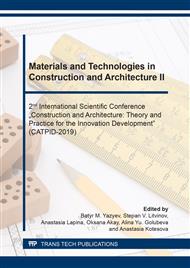[1]
V. Mechtcherine, J. Schulze, Ultra-ductile concrete–material design concept and testing, CPI Concrete Plant International. (5) 88–98.
Google Scholar
[2]
V.S. Lesovik, L.A. Suleymanova, K.A. Kara, Energy-Efficient aerated concrete on composite binders for monolithic construction, Proceedings of higher educational institutions, Construction. 3 (2012) 10–20.
Google Scholar
[3]
A.N. Sapelin, M.Y. Elistratkin, Lightweight concrete a new generation, Bulletin of BSTU named after V.G. Shukhov. 4 (2014) 79–83. (In Russian).
Google Scholar
[4]
R.S. Fediuk, V.S. Lesovik, A.V. Mochalov, K.A. Otsokov, I.V. Lashina, R.A. Timokhin, Composite binders for concrete of protective structures, Magazine of Civil Engineering. 82 (6) (2018) 208–218.
Google Scholar
[5]
S.V. Klyuyev, Yu.V. Guryanov, External reinforcing of fiber concrete constructions by carbon fiber tapes, Magazine of Civil Engineering. 1 (2013) 21-26. (In Russian).
DOI: 10.5862/mce.36.3
Google Scholar
[6]
K.N. Ivanovna, Z.I. Vladimirovich, F.E. Viktorovna, L.M. Sergeevich, E.E. Ivanovich, Features of phase transformations in geopolymers based on bottom-ash mixture containing nano-sized component International Journal of Pharmacy and Technology. 8 (4) (2016) 24808-24816.
Google Scholar
[7]
N.I. Alfimova, M.S. Sheychenko, S.V. Karatsupa, E.A. Yakovlev, A.S. Kolomatskiy, N.N. Shapovalov, Features of application of high-mg technogenic raw materials as a component of composite binders. Advances in Environmental Biology. 8 (13) (2014) 134–138.
Google Scholar
[8]
N.I. Alfimova, Y.Yu. Vishnevskaya, T.G. Yurakova, N.N. Shapovalov, I.G. Luginina, On the question of the hardening of composite binders in conditions of heat and moisture treatment, Bulletin of BSTU named after V.G. Shukhov. 4 (2014) 16–19. (In Russian).
Google Scholar
[9]
E.V. Fomina, V.S. Lesovik, A.E. Fomin, N.I. Kozhukhova, M.S. Lebedev, Quality evaluation of carbonaceous industrial by-products and its effect on properties of autoclave aerated concrete, IOP Conference Series, Materials Science and Engineering. 327 (4) (2018) 04203311.
DOI: 10.1088/1757-899x/327/4/042033
Google Scholar
[10]
N.I. Kozhukhova, E.V. Fomina, I.V. Zhernovsky, V.V. Strokova, R.V. Chizhov, The utilization efficiency of natural alumosilicates in composite binders, Applied Mechanics and Materials. 670-671 (2014) 182-1864.
DOI: 10.4028/www.scientific.net/amm.670-671.182
Google Scholar
[11]
A.V. Cherevatova, I.V. Zhernovsky, M.I. Kozhukhova, D.A. Alehin, The development of composite nanostructured gypsum binder with enhanced heat resistance performance, Materials Science Forum. 945 (2018) 293-298.
DOI: 10.4028/www.scientific.net/msf.945.293
Google Scholar
[12]
I.V. Zhernovsky, A.V. Cherevatova, E.V. Voitovich, N.I. Kozhukhova, E.I. Evtushenko, High-temperature phase transformations in CaO-SO3-SiO2-H2O system with nanosized component, International Journal of Applied Engineering Research. 11 (12) (2016) 7732-7735.
Google Scholar
[13]
Flores-Vivian, R.G.K. Pradoto, M. Moini, M. Kozhukhova, V. Potapov, K. Sobolev, The effect of SiO2 nanoparticles derived from hydrothermal solutions on the performance of portland cement based materials, Frontiers of Structural and Civil Engineering. 11 (4) (2017) 436–445.
DOI: 10.1007/s11709-017-0438-2
Google Scholar
[14]
K. Sobolev, I. Flores-Vivian, R.G.K. Pradoto, M. Kozhukhova, V. Potapov, The effect of natural SiO2 nanoparticles on the performance of portland cement based materials, American Concrete Institute, ACI Special Publication, SP 326 (2018).
DOI: 10.1007/s11709-017-0438-2
Google Scholar
[15]
N.I. Alfimova, E.E. Shadskiy, R.V. Lesovik, M.S. Ageeva, Organic-mineral modifier on the basis of volcanogenic-sedimentary rocks, International Journal of Applied Engineering Research. 10 (24) (2015) 45131–45136.
Google Scholar
[16]
M.Yu. Elistratkin, M.I. Kozhukhova, Analysis of the factors of increasing the strength of the non-autoclave aerated concrete, Construction Materials and Products. 1 (1) (2018) 59–68. (In Russian).
DOI: 10.34031/2618-7183-2018-1-1-59-68
Google Scholar
[17]
N.I. Alfimova, S.Yu. Pirieva, D.V. Gudov, I.M. Shurakov, Е.Е. Korbut, Optimization of receptural-technological parameters of manufacture of cellular concrete mixture, Construction Materials and Products. 1 (2) (2018) 30–36. (In Russian).
DOI: 10.34031/2618-7183-2018-1-2-30-36
Google Scholar
[18]
M.Y. Elistratkin, V.S. Lesovik, L.H. Zagorodnjuk, E.A. Pospelova, S.V. Shatalova, New point of view on materials development, IOP Conference Series, Materials Science and Engineering. 11 (2018) p.032020.
DOI: 10.1088/1757-899x/327/3/032020
Google Scholar
[19]
L.A. Suleimanova, High-quality energy-saving and competitive building materials, products and structures, Bulletin of BSTU named after V.G. Shukhov. 1 (2017) 9–16. (In Russian).
Google Scholar
[20]
I.V. Zhernovsky, N.I. Kozhukhova, Mechanical activation control of activity of silica raw materials of different Genesis, Construction materials, equipment, Technologies of the XXI century. 4 (183) (2014) 52–53. (In Russian).
Google Scholar
[21]
S.M. Rakhimbayev, N.M. Tolypina, E.N. Khakhaleva, Filler adhesion theory by cement stone, International Journal of Pharmacy and Technology. 8 (4) (2016). 24938–24946.
Google Scholar
[22]
N.N. Onoprienko, Sh.M. Rakhimbaev, Influence of viscosity of water-soluble polymers on their efficiency as components of construction solutions, Bulletin of BSTU named after V.G. Shukhov. 3 (2015) 62–66. (In Russian).
Google Scholar


